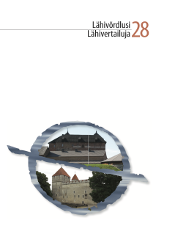Suomi vieraana kielenä -oppikirjojen sisältöjen suhde oman aikansa ilmiöihin: Johannes Aavikin Praktilik Soome keele õpetus (1902) ja Béla Györffyn Gyakorlati Finn Nyelvkönyv (1939)
The relationship of the text contents of the Finnish as a foreign language textbooks with the phenomena of their own time: Johannes Aavik Praktilik Soome keele õpetus (1902) and Béla Györffy Gyarkorlati Finn Nyelvkönyv (1939)
Author(s): Marjut VehkanenSubject(s): Foreign languages learning, Recent History (1900 till today), Finno-Ugrian studies
Published by: Eesti Rakenduslingvistika Ühing (ERÜ)
Keywords: Finnish as a foreign language; the contents of L2 textbooks; L1; Estonian; Hungarian;
Summary/Abstract: My paper concerns the contents and user groups of two textbooks, those of Johannes Aavik (1902) Praktilik Soome keele õpetus (A practical textbook of Finnish) and Béla Györfy (1939) Gyokorlati Finn Nyelvkönyv (A practical Finnish textbook). I will look at the relationship between the contents of these textbooks and the phenomena of the time they were written. From a cultural-historical point of view, I seek solutions in the textual content of the books that refer to linguistic relationships or possible confluences with historical realities at the time the books were published (1902, 1939). My aim is to open up perspectives to the authors’ thought and learning concepts by means of a comparison of the themes of text contents, as well as to possible special assignments set for the books at their publishing time. Te authors are linked to their own time, in this case by the time of publication of the textbook and by the reality of the writing process and the requirements it has created. What in particular can be said about the contents of the texts in these books? In the Hungarian textbook there is a strong emphasis on religious content, as it was intended for students of the Lutheran church. Te Estonian textbook has many fragments of Finnish fiction (Juhani Aho), Finnish songs (Maamme, the national anthem) and also many features of Finnish nationalism due to the difficult Russian grand duchy time. Beforehand I had thought that the texts in the Hungarian textbook were completely disregarding the historical reality of that time (the year 1939), but after reading one particular chapter at the end of the book I realized that the writer was full of worries surrounding him and Europe.
Journal: Lähivőrdlusi. Lähivertailuja
- Issue Year: 2018
- Issue No: 28
- Page Range: 392-422
- Page Count: 31
- Language: Finnish

